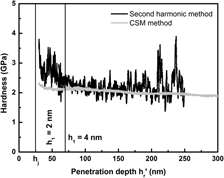Crossref Citations
This article has been cited by the following publications. This list is generated based on data provided by
Crossref.
Guillonneau, G.
Kermouche, G.
Bec, S.
and
Loubet, J.-L.
2014.
A simple method to minimize displacement measurement uncertainties using dynamic nanoindentation testing.
Tribology International,
Vol. 70,
Issue. ,
p.
190.
Becton, Matthew
and
Wang, Xianqiao
2014.
Thermal Gradients on Graphene to Drive Nanoflake Motion.
Journal of Chemical Theory and Computation,
Vol. 10,
Issue. 2,
p.
722.
Guillonneau, G.
Kermouche, G.
Teisseire, J.
Barthel, E.
Bec, S.
and
Loubet, J.-L.
2015.
Is the second harmonic method applicable for thin films mechanical properties characterization by nanoindentation?.
Philosophical Magazine,
Vol. 95,
Issue. 16-18,
p.
1999.
Lu, Jie
Sun, Cheng
and
Wang, Q. Jane
2015.
Mechanical Simulation of a Diatom Frustule Structure.
Journal of Bionic Engineering,
Vol. 12,
Issue. 1,
p.
98.
Becton, Matthew
and
Wang, Xianqiao
2016.
Controlling nanoflake motion using stiffness gradients on hexagonal boron nitride.
RSC Advances,
Vol. 6,
Issue. 56,
p.
51205.
Colas, Guillaume
and
Filleter, Tobin
2016.
Advances in Nanocomposites.
p.
77.
Chang, Chao
Garrido, M.A.
Ruiz-Hervias, J.
and
Rodríguez, J.
2017.
On the possibility of reducing the pile-up effect on the Berkovich instrumented indentation tests.
International Journal of Mechanical Sciences,
Vol. 121,
Issue. ,
p.
181.
Volz, T
Schwaiger, R
Wang, J
and
Weygand, S M
2017.
Comparison of three approaches to determine the projected area in contact from finite element Berkovich nanoindentation simulations in tungsten.
IOP Conference Series: Materials Science and Engineering,
Vol. 257,
Issue. ,
p.
012013.
Gao, Wenxiu
Zhang, Zhuolei
Li, Peng-Fei
Tang, Yuan-Yuan
Xiong, Ren-Gen
Yuan, Guoliang
and
Ren, Shenqiang
2017.
Chiral Molecular Ferroelectrics with Polarized Optical Effect and Electroresistive Switching.
ACS Nano,
Vol. 11,
Issue. 11,
p.
11739.
Morgan, Lucy M.
Molinari, Marco
Corrias, Anna
and
Sayle, Dean C.
2018.
Protecting Ceria Nanocatalysts—The Role of Sacrificial Barriers.
ACS Applied Materials & Interfaces,
Vol. 10,
Issue. 38,
p.
32510.
Kontomaris, Stylianos-Vasileios
and
Malamou, Anna
2018.
An extension of the general nanoindentation equation regarding cylindrical—shaped samples and a simplified model for the contact ellipse determination.
Materials Research Express,
Vol. 5,
Issue. 12,
p.
125403.
Dmitruk, Anna
Żak, Andrzej
Naplocha, Krzysztof
Dudziński, Włodzimierz
and
Morgiel, Jerzy
2018.
Development of pore-free Ti-Al-C MAX/Al-Si MMC composite materials manufactured by squeeze casting infiltration.
Materials Characterization,
Vol. 146,
Issue. ,
p.
182.
OTTO, Mateusz
ZIMOWSKI, Sławomir
SIKORA, Wojciech
and
MOSKALEWICZ, Tomasz
2019.
MECHANICAL AND TRIBOLOGICAL ANALYSIS OF MONOLITH
AND COATING POLYETHERETHERKETONE.
Tribologia,
Vol. 286,
Issue. 4,
p.
73.
Ouachan, I
Kuball, M
Liu, D
Dyer, K
Ward, C
and
Hamerton, I
2019.
Understanding of Leading-Edge Protection Performance Using Nano-Silicates for Modification.
Journal of Physics: Conference Series,
Vol. 1222,
Issue. 1,
p.
012016.
Banday, Summèra
and
Wàňi, M.F.
2019.
Nanomechanical and nanotribological characterization of multilayer self‐lubricating Ti/MoS2/Si/MoS2 nanocoating on aluminium‐silicon substrate.
Surface and Interface Analysis,
Vol. 51,
Issue. 6,
p.
649.
Texter, John
Qiu, Zhiming
Byrom, Joe
and
Crombez, Rene
2019.
Reactive Nanofluids for Tuning Resin Hardness.
MRS Advances,
Vol. 4,
Issue. 2,
p.
125.
Guillonneau, Gaylord
Wheeler, Jeffrey M.
Wehrs, Juri
Philippe, Laetitia
Baral, Paul
Höppel, Heinz Werner
Göken, Mathias
and
Michler, Johann
2019.
Determination of the true projected contact area by in situ indentation testing.
Journal of Materials Research,
Vol. 34,
Issue. 16,
p.
2859.
Borisenko, Elena
Borisenko, Dmitrii
Bdikin, Igor
Timonina, Anna
Singh, Budhendra
and
Kolesnikov, Nikolai
2019.
Mechanical characteristics of gallium sulfide crystals measured using micro- and nanoindentation.
Materials Science and Engineering: A,
Vol. 757,
Issue. ,
p.
101.
Chen, Wei
Liu, Yiping
Jiang, Zhenyu
Tang, Liqun
Liu, Zejia
and
Zhou, Licheng
2019.
Modeling of Compressive Strength for Unidirectional Fiber Reinforced Composites with Nanoparticle Modified Epoxy Matrix.
Materials,
Vol. 12,
Issue. 23,
p.
3897.
Al-Tameemi, H.A.
Long, H.
and
Dwyer-Joyce, R.S.
2019.
Damage characterisation of white etching cracks in a black oxide coated wind turbine gearbox bearing.
Wear,
Vol. 432-433,
Issue. ,
p.
102923.



